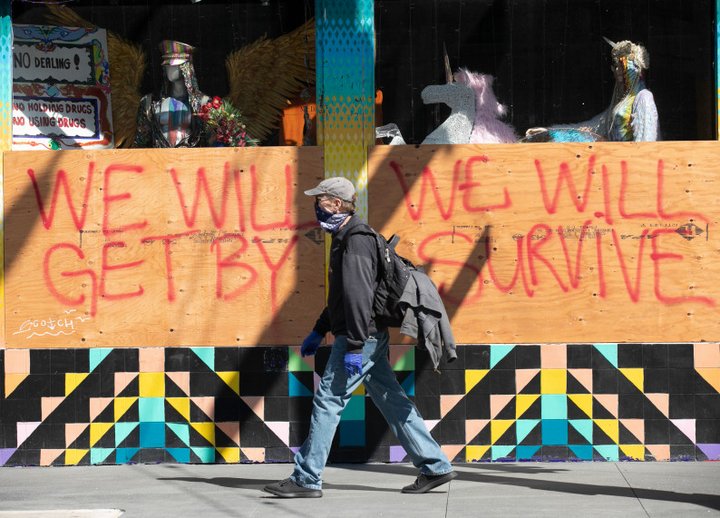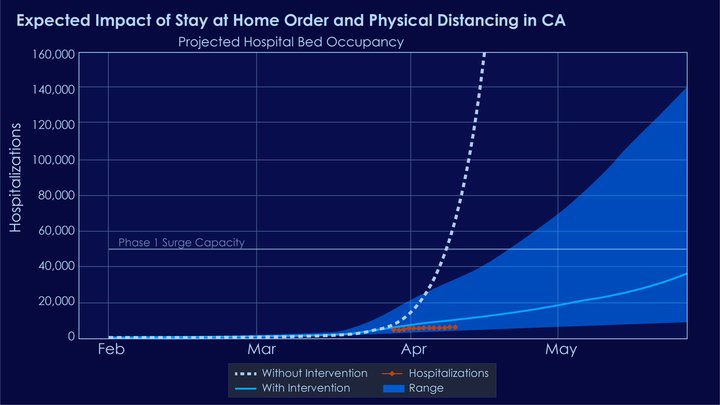
A man wearing disposable gloves and a bandana over his face walks past a boarded up shop on Haight Street in San Francisco on April 7, 2020. California is entering the fourth week of sheltering in place to limit the spread of the novel coronavirus, and the number of Californians hospitalized and those in ICUs with COVID-19 is starting to edge up only slightly. Photo by Anne Wernikoff for CalMatters
###
Just a few days out from a forecasted peak in California’s coronavirus battle, the state is experiencing fewer COVID-19 hospitalizations than anticipated — and even better than expected under a stay-at-home order, according to Gov. Gavin Newsom’s daily update.
Projections from the University of Washington’s Institute for Health Metrics and Evaluation have estimated California would reach its coronavirus peak on April 14. But if current trends continue for the next four days, it will hardly be a spike at all, said state officials, who have relied on estimates that California’s coronavirus toll would peak in May.
“The difference of what we are seeing now may not be that different than the peak we are going to see in the future,” said Mark Ghaly, secretary of the state Health and Human Services Agency.
Newsom and his team tempered their optimism over the latest state numbers on hospitalizations, intensive-care patients and deaths. Their expressed concern: If Californians do not continue to maintain physical distance and shelter in place — especially over this Easter weekend — the tide could turn quickly.
“Let’s continue to hold the line and do this together,” Newsom said. “Give us a few more weeks to see where these trend lines go.”
The number of Californians hospitalized from COVID-19 rose 2.5% between Thursday and today, with 72 people newly hospitalized. Those in intensive-care units ticked up about 1% after actually dropping by about 1% the previous day. CalMatters is tracking hospitalizations by county here.

The red dotted line on this state-produced graphic illustrates how California’s COVID-19 hospitalizations are falling below projections.
Newsom also announced that 541 people have died as a result of coronavirus infection, up nearly 10% from the previous day.
A total of 19,472 people in California have tested positive since the outbreak began., although testing has continued to lag in the state.
Ghaly also credited the stay-home order and social distancing for the positive trend, but added that this weekend is hugely important to fend off a spike in the pandemic here.
“I caution you, this line could easily start to see an upward slope..if we lose the focus on physical distance and stay at home,” Ghaly said.
Not all news coming in from the field was positive: The fallout from the state’s shelter-in-place order has crippled the economy. In the last month, 2.3 million people filed for jobless benefits in California, taxing the already stretched state system. Frustration has ratcheted up because a jammed hotline — established to answer questions about how to file an application or check the status of a claim — was open only four hours a day.
Today Newsom acknowledged the exasperation, and announced that the state Employment Development Division would start staffing the hotline from 8 a.m. to 5 p.m. weekdays.
As for the health prognosis, University of California, San Francisco epidemiologist Jeff Martin said focus not on models or projections, but real data. He echoed the Newsom administration — identifying a positive trend, but warning that cases could jump if Californians let down their guard.
“Hospitalization, ICU admission and deaths, they do tell us what is going on,” he said. “This is actual data.” And the fact that the data is showing no big spikes is crucial.
“That is what makes me optimistic of what we are doing right now,” Martin said. “We may not see a peak and then a quick fall. We could see a continuation of what we are seeing right now.”
The results differ in locales across the state, and that is going to mean that every county is going to have to decide when and how to start to lift restrictions based on their cases, Martin said.
Counties that experienced decreases in the number of positive cases included Alameda, Mono, Orange, San Francisco and Santa Barbara. And some counties still have no cases or suspected patients, including Alpine, Calaveras, Lake and Sutter.
Neha Nanda, hospital epidemiologist at the University of Southern California’s Keck Hospital in Los Angeles, said it’s too early to declare victory given that over the last two weeks, the state has added hundreds of cases daily and the death toll has continued to rise.
“When for 14 days you haven’t had any new cases, that is when you can say with confidence that we have made headway,” she said. “I’m not going to say we haven’t made headway. We are likely moving in the right direction. But we have to keep doing what we are doing: aggressive testing, self-isolation and making sure we are good about washing hands.”
Nanda praised California for being proactive by calling for social distancing and sheltering at home early on. The state’s geography also helps, she said, because folks are more spread out than in other places, like New York.
Experts give credit to leaders in San Francisco for sounding the alarm and declaring a state of emergency early on by issuing the first stay at home order, which was followed by a statewide call for the same.
Still, across the state Californians are starting to get restless, especially on the eve of one of the most popular holidays of the year. And while Newsom did not proclaim the Easter Bunny an essential worker, like the prime minister of New Zealand did last week, he said there are ways for folks to celebrate without getting too close.
“Practice your faith but do so in a way that allows you to keep yourself healthy and keep others healthy and does justice to the teaching of Christ, God and others,” Newsom said.
Armand Dorian, chief medical officer and an emergency room doctor at USC Verdugo Hills Hospital, has posted videos on Instagram thanking everyone for staying in and contributing to what he calls a “significant improvement.” But he is imploring them to stay the course too.
“We are very close to getting over this hump, the peak is about to occur,” he said.
It could be weeks before it is clear when restrictions will ease up. Predicting that is uncharted territory, experts say.
“The challenge here is we don’t know enough about the virus and any projection made today can be inaccurate a week out,” Nanda said. “It’s really testing our ability as a world. How nimble are we to modify our operations and modify our strategies as it relates to patient care or recreation, almost everyday?”
Plus, a large number of people are still susceptible to the infection and that could drive a second surge if resuming regular activities happens too soon or too quickly, Martin said.
“It’s all going to come down to identifying the small brush fires and prevent them from becoming raging wildfires,” he said.
###
CALmatters.org is a nonprofit, nonpartisan media venture explaining California policies and politics.
CLICK TO MANAGE